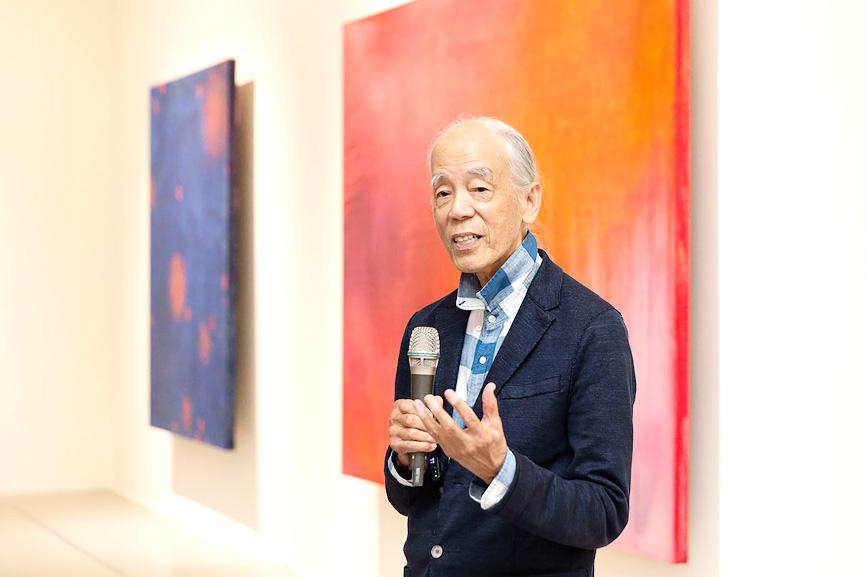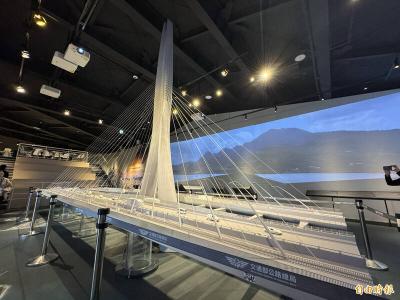A retrospective of more than 200 works by Paul Chiang (江賢二) is now open at the Taipei Fine Arts Museum (TFAM), his first solo exhibition at the museum.
Art critic Jason Wang (王嘉驥), who has curated more than 40 exhibitions, including the inaugural Taiwan Biennial in 2008 and the Taiwan pavilion at the 51st Venice Biennale in 2005, was invited to be the guest curator of the exhibition, the museum said.
The works in “Paul Chiang: A Retrospective” (江賢二:回顧展) span Chiang’s 55-year career from the mid-1960s to today, the museum said.

Photo: CNA
Born in 1942 in what is now the special municipality of Taichung, Chang graduated from National Taiwan Normal University in 1965 before moving abroad., it said.
He studied and lived in Paris and New York from the late 1960s to the 1980s, it said.
Early in his career, he would shut the windows in his studio and paint in the absence of natural light, it said.
The series Hundred Year Temple (百年廟) includes some of the first works that Chiang painted after returning to Taiwan in the 1990s, the museum said.
Like his earlier series Notre Dame de Paris (巴黎聖母院), painted when he lived in the French capital, Hundred Year Temple uses somber images to capture the spiritual experience of religious sites, it said.
Chiang moved to Taitung County in 2008, where he has since created the Pisilian (比西里岸之夢) series, among other works, it said.
There, “the window that the artist had kept shut for years finally opened,” the museum said, adding there is a colorfulness in Chiang’s later paintings not found in his early works.
Chiang’s works also pay homage to classical music, which he has loved from an early age, and is “spiritual food” in his daily life, it said.
The retrospective, which opened on Saturday last week, runs through June 14.

Chinese President Xi Jinping (習近平) is unlikely to attempt an invasion of Taiwan during US president-elect Donald Trump’s time in office, Taiwanese and foreign academics said on Friday. Trump is set to begin his second term early next year. Xi’s ambition to establish China as a “true world power” has intensified over the years, but he would not initiate an invasion of Taiwan “in the near future,” as his top priority is to maintain the regime and his power, not unification, Tokyo Woman’s Christian University distinguished visiting professor and contemporary Chinese politics expert Akio Takahara said. Takahara made the comment at a

Upon its completion next year, the new Tamkang Bridge (淡江大橋) in New Taipei City is to be an important landmark in Taiwan, alongside Taipei 101, Minister of Transportation and Communications Chen Shi-kai (陳世凱) said today. The bridge is scheduled to be completed in December next year and open to the public in the first half of 2026, connecting New Taipei City’s Tamsui (淡水) and Bali (八里) districts. It is an asymmetric single-tower suspension bridge, nearly 70 stories tall, designed by world-famous architect Zaha Hadid. The bridge aims to alleviate traffic in Tamsui and on the Guandu Bridge (關渡大橋), in addition to increasing the

EXERCISES: A 2022 article by a Chinese intelligence expert identified at least six People’s Liberation Army assault boats hidden inside the Hong Kong-flagged ship A Hong Kong-flagged cargo ship that had been docked at Taichung Port and which previously took part in Chinese military exercises departed from the port on Saturday, the Taiwan International Ports Corp’s Taichung branch said yesterday. The statement came in response to a post on the social media platform X by Taiwan-based journalist Chris Horton that said the ship, the SCSC Fortune, had been docked at the port since Tuesday and questioned whether Taiwan has any rules regarding foreign civilian vessels that have participated in People’s Liberation Army (PLA) exercises. Horton referenced a 2022 article by Chinese intelligence expert Rod Lee that

PROBLEMATIC: Popular hotpot restaurant chains were among the list of restaurants that failed the inspection and have been ordered to remove bad ingredients The Taipei Department of Health’s latest inspection of hotpot ingredients in hotpot restaurants resulted in a 16.7 percent failure rate. Eight vegetables had excessive pesticide residue and two other items had aflatoxin and excessive preservatives. As the weather is getting colder, more people eat at hotpot restaurants so a random inspection of ingredients was conducted in October to ensure food safety, the department said. Food and Drug Division Director Lin Kuan-chen (林冠蓁) said 60 different ingredients were tested: 15 high-risk vegetables, 15 processed food items, 10 soy-based food items, five meat items, five lamb items, five seafood items and five peanut powder